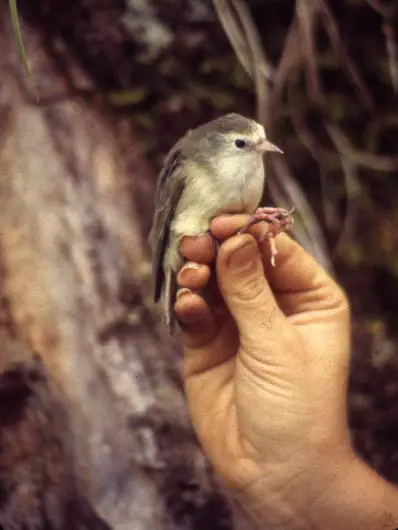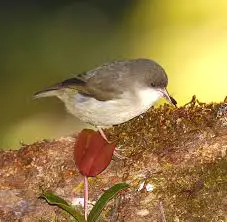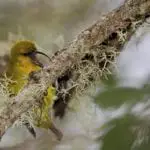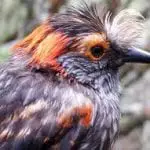Scientific Facts
| Common Name | ʻAkikiki |
| Scientific Name | Oreomystis bairdi |
| Lifespan | Unknown |
| Size | 13cm. |
| Mass | 12 – 17 grams |
| Habitat | High elevation (1000 – 1600 meters) wet forests |
| Origin & Range | Kauaʻi, Hawaiʻi |
Information & Physical Appearance
Scientifically referred to as Oreomystis bairdi, the Akikiki is an endemic species found exclusively on the island of Kaua’i, Hawaii. This unique, energetic, bicolored bird is one of the rarest Hawaiian honeycreepers and is also known as Kaua’i Creeper.
Nowadays, only 18 of the iconic for the island of Hawaii honeycreepers still exist. In the past, there were at least 56 species of Hawaiian honeycreepers, most of which have gone fully extinct up-to-date, while the remaining ones are threatened with extinction.The Akikiki is part of the phylum Craniata, order Passeriformes, family Fringillidae. Like all the Hawaiian honeycreepers, the Akikiki is a distant, yet close relative of rosefinches.
The specialized bill is a result of adaptive radiation in a restricted, specific environment. The bill is de-curved, short, and pale pink in color.Apart from the specialized bill, this bird’s strong, pink feet and legs are well-adapted to suit the foraging habits of Oreomystis bairdi.
The upper part of the Akikiki’s body displays soft gray coloration. The lower portion of the body exhibits white coloration.
The head, sides, flanks, and back are characterized by hues of dark gray to olive. The under tail coverts, belly, breast, and throat zone are colored in white to off-white nuances.
“Equipped” with a short tail, these birds have a stocky appearance.
Both male and female Akikiki birds share the very same set of colors in their plumage. Because of this, it is impossible to tell apart males from females at a mere glance, as they are not sexually dimorphic.
This species is one of the smallest Hawaiian honeycreepers, reaching up to 12cm. in length and up to 17 grams of weight.
Lifespan

Up-to-date, there isn’t much data available when it comes to the life expectancy of individual Oreomystis bairdi species. However, scientists have managed to gain a better understanding of Hawaiian honeycreepers’ life expectancy, thus, being able to roughly estimate the expected lifespan of each.
Fortunately, thanks to the dedicated hard work of researcher Andrew Berger, and in particular, the information shared in issue #2 of The Wilson Bulletin, where Berger’s article on the longevity of Hawaiian honeycreepers raised in captivity was published, mankind was given the first recorded data on the average lifespan of Hawaiian honeycreepers.
Berger examined the life expectancy of several species of Hawaiian honeycreepers raised in captivity, namely the Kaua’i Amakihi, the Anianiau, the Nihoa finch, the Hawaii Amakihi, the Apapane, and nonetheless, the Akikiki.
Only the Anianiau, the Kaua’i Amakihi, and the Apapanelived for almost 10 years in captivity. The Akikiki, the Hawaii Amakihi, and the Nihoa finch lived for 4 and up to 5 years in captivity.
It is important to note that even though it can be hypothesized that all Hawaiian honeycreepers, including but not limited to the Akikiki, may likely manage to live to up to 10 years in captivity, any data on the Akikiki’s life expectancy in the wild is still lacking.
Additionally, it is highly likely that these birds will have a shorter lifespan in the wild, as opposed to those displaying captive adaptation based on Berger’s research.
Furthermore, the current survival threats the Akikiki faces do greatly contribute to the shorter generation lifespan. Each generation of Akikiki has been found to last for up to 5.7 years. This indicates that each individual actually has a significantly shorter lifespan.
Ecosystem & Habitat

Currently, the Akikiki is found only and solely in Kauai, and in particular, exclusively in the highest elevations of the Alaka’i Wilderness Preserve and the rainforests of Koke’e State Park.
Based on subfossil records, this bird species was once abundant at sea level. It is suggested that the Akikiki may have inhabited a significantly wider range of habitats, as compared to the rather limited area it occupies up-to-date. In fact, it is believed that the Akikiki has also inhabited dry forest habitats back in time.
Rarely found outside of Alakai Wilderness Preserve’s Sincock Bog, the Akikiki occurs at elevations between 1000 and 1600 meters in the native wet forests of Kauai.
The survival of this bird species is intricately related to its habitat. The habitat must be densely covered in trees. In return, the trees must support a tree-fern understory, allowing the birds to successfully climb the branches and bark when foraging for food, with the elevation range averaging between 600 and up to 1600 meters.
Between 1970 and 2000, severe decreases in these birds’ distribution were shown, with the occupied area has shrunk from 88 to 36 square kilometers.
Food & Diet

Image Source
Because of foraging by curiously hopping along the branches and trunks of dead and live trees alike, the akikiki is often compared to its North America counterparts – nuthatches.
These birds are mainly insectivorous. The diet of Akikiki birds consists of arthropods, such as beetles and caterpillars, among others, which are picked while the birds are hopping along the bark of native trees’ branches and trunks.
Behavior

Image Source
Adult akikiki communicate by contact calls. The contact calls is a short whit or weet. Sometimes, the contact call may be doubled.
Interestingly, the contact call of the mature, adult Akikiki bird may resemble the contact call of the anianiau bird, as these species may flock together.
It is exclusively during the breeding season when Akikiki birds do also sing. The song is described as a descending trill.
The juvenile Akikiki is to beg by a stammering series of chits, known as a begging call. It is during the breeding season when mature females are to use a very similar call in order to solicit feeding, which is done by the males.
The existing research on nest success, reproductive rates, parental care of nestlings, as well as the bird’s movements and survival rates among juveniles and adult Akikiki birds is considered very scarce, with fieldwork being quite unsuccessful as of now, because of the extreme difficulties in observing the habits and behavior of the Akikiki.
However, based on the limited findings available on the behavior of some Akikiki individuals in the wild, researchers have managed to gain some important insights.
Two Akikiki individuals were observed while engaged in foraging activities by researchers Roberts and VanderWerf.
The birds were foraging the twigs and branches of an olapa tree that was partially dead. They were excavating rotten wood right from the center of a twig, searching for larvae, while simultaneously probing the tree’s bark for insects.
Another pattern of behavior that experts managed to observe was that of a pair of Akikiki birds caring for their young. The female was recorded to sit on the nest most of the time. She would only leave the nest once for as little as 20 minutes. Before passing the food to her nestlings, the female was fed by the male.
In the same tree where the pair of Akikiki were observed, other bird species were also found to thrive, namely Aniuaniau, Apapane, and Japanese White-eyes. Some of these bird species would, at times, come very close the Akikiki’s nest.
Curiously enough, when the Akikiki’s nest was approached by other bird species sharing the same tree habitat, the Akikiki mother did not show any negative reactions. Instead, she tolerated other birds’ presence, which made the researchers conclude that the mother did not perceive other bird species as threats.
Even though the breeding biology and behavior of Akikiki remain a rather obscure topic that requires further investigation, researchers have managed to discover that both males and females share responsibilities when it comes to the construction of the nest.
Furthermore, it has been found out that males are the ones in charge of feeding the females while nesting, while only females were the ones to oversee incubation.
Some of the behaviors shared above are also common in other species of Hawaiian honeycreepers. However, the observed excavation of branches while the Akikiki were searching for insect larvae has never been previously seen in honeycreepers.
Additionally, it remains unclear whether the nesting and caring for the young behaviors exhibited by the Akikiki is also typical for other honeycreepers or not at all, and so these particular characteristics may further add to the uniqueness of the Akikiki bird.
Reproduction
Up-to-date, only a few Akikiki nests have been discovered in the wild. However, it is known that nesting takes place from March and up until June.
Both males and females are to construct the nest. The nest is built with the user of lichen and moss and is positioned several meters up in the native ohia trees (Metrosideros polymorpha).
While only the female is to incubate the eggs, both of the parents are to feed nestlings and fledglings. Each breeding season, only a single brood is raised, which is mainly due to the quite long juvenile dependency period.
The first Akikiki nest to have been ever found and collected was thanks to the collective effort of the San Diego Zoo, the U.S. Fish and Wildlife Service, and the Kauai Forest Bird Recovery Project. Being the first of their kind, the collected eggs were used for the planned reintroduction of the Akikiki in the wild, which will hopefully aid the recovery of this unique bird species, thanks to a captive breeding population.In 2018, with the assistance of the San Diego Zoo, the first captive-bred Akikiki was born.
Health Risks, Survival Threats & Conservation
Climate change is the major threat to the well-being and survival of the Akikiki.
Ultimately, even though climate change is affecting planet Earth in numerous ways, one of which includes the negative effects inflicted upon biodiversity, it is endemic species that are most vulnerable to the adverse consequences related to the climate crisis. That’s because endemic species, including but not limited to the Akikiki, are found exclusively in certain parts of the world, thus, becoming much more susceptible to changes related to disease, habitat, and human activity, among other stochastic events. The natural habitat of Oreomystis bairdi has been greatly reduced. Habitat loss is associated with severe deforestation, as well as the deterioration caused by various invasive species.
Most Hawaiian honeycreepers have very little immunity to Avian malaria caused by non-native mosquitoes introduced to the island by humans a century ago. Avian malaria strongly affects birds below 1000 meters elevation. This further restricts the range of the akikiki significantly.
Mosquito-borne diseases that have decimated and keep decimating the Akikiki populations may worsen in the future due to climate change, as with the rise in temperatures, the elevation where the deadly mosquitoes thrive will also rise, further shrinking the birds’ already restricted habitat.
The rats, as well as the cats introduced to the island by humans, are considered major predators of the akikiki’s eggs and nestlings alike. Additionally, the competition for both food and space with non-native birds, like the Japanese white-eyes, is also believed to affect the numbers of akikiki birds left in the wild.
Pigs, goats, and sheep do further destroy the birds’ habitat, while introduced non-native plants are overcrowding the native plant species on the islands, while it is with the native plant species that native animal species share a deep, crucial ecological relationship.
It was in 2000 when the ʻakikiki was officially listed as critically endangered on the IUCN Red List of Threatened Species. In fact, the unique bird used to be a candidate for receiving status under the Endangered Species Act ever since 1993, yet it wasn’t before 2010 when the bird was finally listed as endangered species under this act.
Unfortunately, despite being listed under the Endangered Species Act, the Akikiki, similarly to other birds endemic to Hawaii, do only receive a very small percentage of funds dedicated to recovery.
Since very little is known about the akikiki bird even up-to-date, the major focus of recovery efforts has been the better understanding of the bird’s biology, and the estimation of the current population size. Future recovery plans include captive breeding programs, reintroduction, as well as habitat restoration.
Additionally, even the locals know so very little about the Akikiki and other native birds alike. Because of this, very few voices are raised when it comes to advocating for increased conservation efforts and resources.
On the bright side, the ABC Hawaii Program has made the Akikiki’s conservation, as well as the conservation of other native forest birds, a top priority.
The hurricanes in 1982 and 1992 have also strongly impacted the habitats of native forest birds on Kaua’i Island.
Because of human activity and the effects of global warming, the weather patterns in the Alaka’i Plateau region have also been altered, leading to a rather reduced area of elevated regions characterized by cool temperatures where this bird species are known to reside. Forced to farther upward, the Akikiki populations are slowly and surely getting confined to smaller and smaller regions, thus, continuously running out of suitable habitat.
The increased destruction of highly elevated areas where the Akikiki thrives is a result of human development. Tragically, the loss of Akikiki populations makes it even harder for this one-of-a-kind species to be able to survive and recover.
Even if conservation efforts lead to the successful recovery of this species, stochastic events will still have major impacts, since genetic diversity will not be able to return to the levels that existed decades ago, and so conservationists will need to constantly keep a close eye on the vulnerable Akikiki populations for years to come.
One of the conservation actions being taken includes the decrease of both the presence and influence of ungulates. This has been done by the construction of large fences, however, maintaining fencing is an extremely difficult, and nonetheless, expensive endeavor, yet it has proven to provide excellent results by allowing native plants to regrow in certain areas.
Sadly, in certain parts of Hawaii, the conservation efforts keep failing because of the governmental and social pressure for maintaining recreational use areas.
Another conservation action includes the elimination of as many rodents and invasive plant species as feasible, leading to a major improvement in protecting the nests of Akikiki birds, as to provide these creatures’ populations a higher chance to recover over time.
The overall increase in protected areas, continuous predator control, the addition of protected sites located at upper elevations, and nonetheless, the construction of more fences, will hopefully help in the successful recovery of the Akikiki. Adding more upper-elevation sites is of extreme importance, as it will provide great and much-needed relief for this bird species, and thanks to the collapse of Hawaii’s sugar industry, more spare land is available.
Unfortunately, spare land is most commonly used for increased urban development and modern-day housing, so the Hawaiian government and research organizations still have a very long and steep way to go in saving the native Akikiki species.
Availability – Where to Get an Akikiki

The Akikiki is a critically endangered bird that is endemic to Kauai, Hawaii, and therefore, it cannot be kept as a pet.
Even though one cannot get an Akikiki in the same sense as one can get a canary, it is possible to get closer to these one-of-a-kind feathery creatures by experiencing their natural habitat. For this purpose, one can choose to visit the Sincock Bog in the Alakai Wilderness Preserve. It is possible to camp near Sincock Bog.
Interesting Facts
1. Being an active and agile bird, the Akikiki is often described as Hawaii’s version of a nuthatch. Similarly to nuthatches found in North America, the Akikiki is to sometimes hang upside-down while pursuing its insect prey.
2. The first person to describe the Akikiki was Leonhard Stejneger. He managed to describe the unique bird thanks to a specimen which was collected by the local naturalist Valdemar Knudsen.
Back in the 1900s, early collectors were to describe the Akikiki as a bird species that is ubiquitous and “abundant” at elevations over 300 meters.
In 1981, Kauai’s Island Hawaiian Forest Bird Survey did also find the Akikiki to be fairly common, although in the more remote parts of its natural range. 3. The Akikiki has never really been in the very focus of explicit research study, even nowadays, when the severe decline of this species is witnessed. Thus, the Akikiki remains one of the most mysterious, and most poorly understood of all the extant birds inhabiting the Islands of Hawaii.
4. It was in 2015 when Prakash Vaithyanathan, a high-school teacher in India, suggested naming a celestial body after the unique Hawaiian honeycreeper Akikiki. The suggestion happened during the IAU General Assembly conducted in Hawaii in 2015. Finally, an asteroid that used to be named “7613” was successfully renamed “Akikiki 7613.”
How to Care for the Akikiki
The best way to care for the Akikiki is to address climate change effects on a personal and global level. Also, it is crucial to raise awareness over the current conservation efforts that direly need further support.
Currently, there are different programs that work with numerous partners in order to ensure the Akikiki’s future, and anyone is free to make a donation or to seek other ways to help these programs increase in scope and efficiency.
Ultimately, the future survival of the Akikiki is entirely in the hands of humans, and the only way to make a difference for this special bird is if more people are to engage in the process together.
FAQ Section
What Does the Akikiki Look like?
The Akikiki is a very small, bicolored bird characterized by a decurved, short bill, gray upperparts, and white underparts.
Is the Akikiki Endangered?
Yes, the Akikiki is listed as Critically Endangered on the IUCN Red List of Threatened Species.
Why is the Akikiki Endangered?
The Akikiki is endangered with extinction because of several intricately related factors, namely habitat loss and degradation, invasive, non-native animal and plant species, urban housing, and climate change.
Is the Akikiki a Honeycreeper?
Yes, the Akikiki is one of the honeycreepers that are endemic to the Hawaiian Archipelago. It is one of the rarest and the smallest of the Hawaiian honeycreepers that can still be found in the wild.



